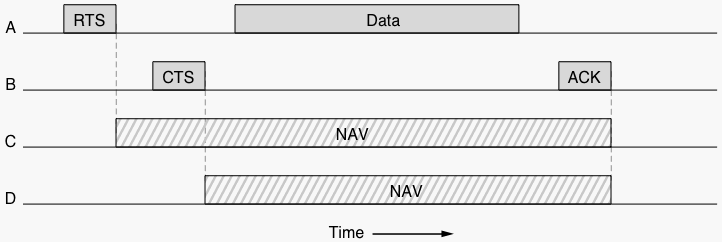802.11 Collision Avoidance, continued
Consider the situation of 4 nodes.
You can imagine that we have 4 nodes left-to-right, named C, A, B, D.
- A wishes to communicate with B,
- C can hear only A, and
- D can hear only B.
- A observes an idle medium,
and initially sends a Request to Send (RTS) frame to B.
This frame includes a field indicating how long (in microseconds)
the actual data frame will be,
i.e. how long the sender wishes to hold the medium.
- When B receives the RTS it replies with a Clear to Send (CTS)
frame, also carrying the length of the data frame.
- Any other node hearing the RTS frame (e.g. C) knows that A is making a
request, and should not itself transmit until the indicated length/time
has elapsed.
- Any node hearing the CTS frame (e.g. D) must be close to the receiver
(B) and therefore should also not transmit for the indicated length of time.
- Any node that hears the RTS frame, but not the CTS frame,
knows that it is not close enough to the receiver to interfere,
and so is free to transmit (but must first transmit its own RTS...).
CITS3002 Computer Networks, Lecture 4, Local Area Networks (LANs and WLANs), p20, 20th March 2024.
|


 CITS3002
CITS3002 help3002
help3002 CITS3002 schedule
CITS3002 schedule